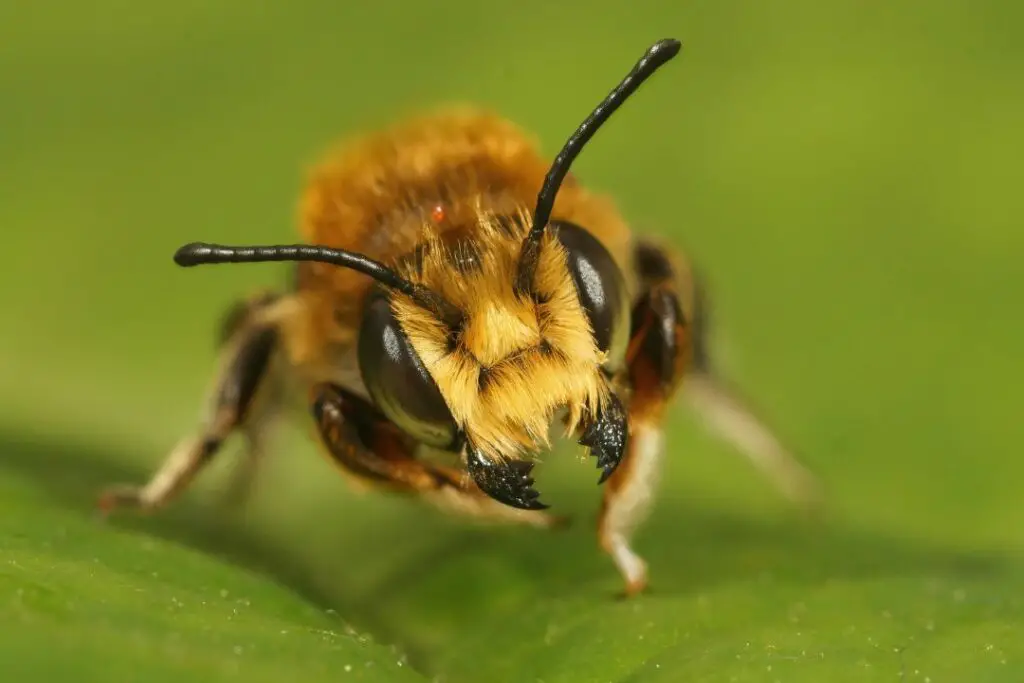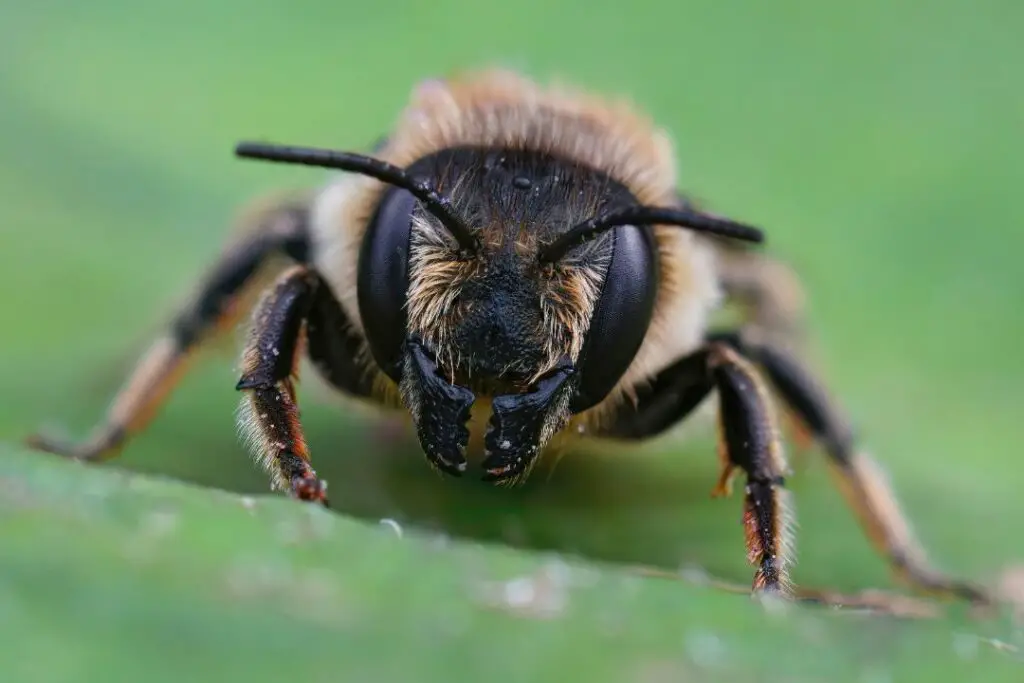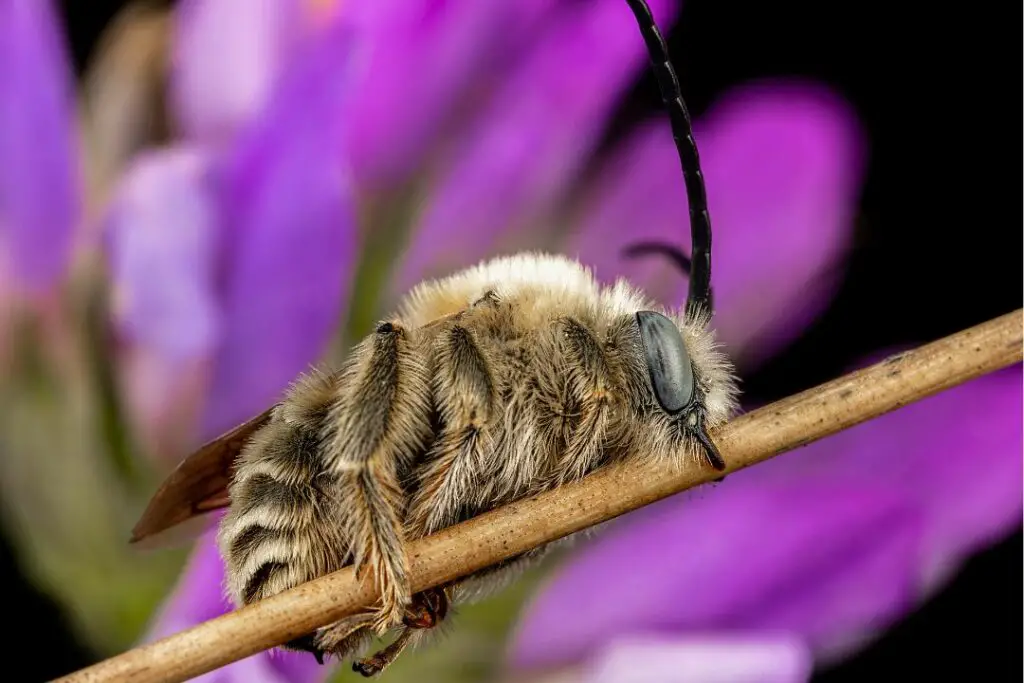Bees are well known for their painful stings, but did you know bees can bite as well?
Yes, bees are equipped with a powerful bite that, while rarely used, is still an effective deterrent to potential predators.
Let’s dive into the fascinating world of bees to learn more about bee bites and why they happen.

The Difference Between Stinging and Biting
When we think of bees, the immediate thing that comes to mind is their painful barbed stinger. But what about biting?
Before we dive into the specifics, it’s really important to learn the difference between a bee’s sting and its bite.
The sting
Bees, especially the well-known honey bee (Apis mellifera), possess a stinger, an evolved ovipositor (an organ some insects use to lay eggs).
When a bee feels threatened, it may sting to defend itself or its hive. When a honey bee stings a mammal, it often leaves behind the stinger, venom sac, and some internal organs, causing its death. This self-sacrificial act is a desperate move to ward off potential threats.
The bite
On the other hand, biting is a less discussed behaviour among bees. Bees have strong mandibles (jaws) that they primarily use for handling wax, building their hive, grooming, or handling pollen.
These mandibles aren’t typically used to defend against significant threats like humans but can be very effective against other insects.
Which bees bite?
Most bees can bite using their mandibles (jaws) but mainly use them for hive-building, grooming, or handling pollen. But there are a few rare cases when bees employ a powerful bite.
- Drones: Male honey bees, known as drones, do not have stingers. While they can technically bite, they rarely do, and even if they did, their bite would be inconsequential to humans purely due to their small size.
- Giant Honey Bee (Apis dorsata): The giant honey bee is one bee species known to bite intruders, including humans when protecting its hive. This bite is more of an annoyance than a significant pain and is secondary to their primary defence, which is stinging.
- Stingless Bees: As the name suggests, various species of stingless bees (from the tribe Meliponini) do bite. They can be pretty aggressive if their nest is threatened. Their bite can be somewhat painful but not severe, given their small size.
- Solitary Bees: Some solitary bees might bite if trapped or handled, though this is less common and won’t cause any lasting damage.
When bees feel threatened, they prefer to flee rather than engage. Biting is usually a last-resort mechanism or happens in specific situations where the bee cannot sting or feels that biting is more appropriate, like when handling intruders of the same species or other small insects.

How Do A Bee’s Mandibles Work?
A bee’s mandibles, akin to jaws in mammals, are robust, often toothed structures on either side of its mouth. They play several essential roles in the daily life of a bee, and their design and function are tailored to the specific tasks and needs of different bee species.
Here’s how they work in a variety of fascinating tasks.
- Manipulation and handling: Mandibles are crucial for manipulating materials. Worker honey bees use them to shape wax when constructing or repairing their hive. They’re also employed to handle pollen and shape it into “pollen balls” for transport back to the hive.
- Feeding: Bees use their mandibles to process and manage food. They can help break down more substantial food particles or aid in feeding larvae in the hive.
- Defence: When bees face threats from pests like wax moths or hive beetles, they can use their mandibles to bite and remove the intruders.
- Grooming: Bees use their mandibles in grooming. They can clean themselves, removing dirt, pollen, or even varroa mites using their mandibles and legs.
- Tending to the hive: Mandibles are essential tools for removing debris from the hive or handling dead bees.
- Mating Rituals: In some bee species, males use their mandibles during mating rituals, either to hold onto the female or to spar with rival males.
The design of the mandibles varies among bee species. Leafcutter bees use sharp-edged mandibles to cut out pieces of leaves for constructing their nests. Carpenter bees, on the other hand, have strong mandibles adapted for chewing through wood.
In essence, a bee’s mandibles function as multipurpose tools tailored for various tasks crucial to the survival of the individual and the hive.

What Happens When A Bee Bites You?
When people refer to a bee as “biting,” they often mean they’ve been stung by a bee. A sting injects venom and can cause pain, redness, swelling, and, in some cases, allergic reactions.
While bees can indeed bite, as we’ve learnt, their bite doesn’t typically harm humans like a sting does. If you do get bitten, here’s what you can expect.
- Minimal Pain: A bee’s bite might cause a slight pinch or minor pain, but it’s usually much less painful than a bee sting.
- No Venom Delivery: Unlike stinging, there’s no venom involved in a bite from a bee’s mandibles. So, reactions associated with bee stings, like pain, swelling, or more severe allergic responses, aren’t a concern with bee bites.
- Temporary Mark: A bite might leave a tiny mark or slight redness, but this usually fades quickly.
It’s worth noting that some bees, like the stingless bees of tropical regions, might bite more frequently as they don’t have a functional sting for defence. Their bite can be more noticeable, but it’s not harmful like a sting.
In Conclusion
Bees can and will bite and sting, but it’s reserved as a last form of defence. Their powerful mandibles are effective against other insects and smaller creatures but can struggle to pierce humans thicker, more elastic skin.
Want to learn more about the beautiful world of bees? Head over to our guide on which bees sting.
Or look at some of the other great reads below, packed with fascinating insight into the world of bees and other pollinators.




